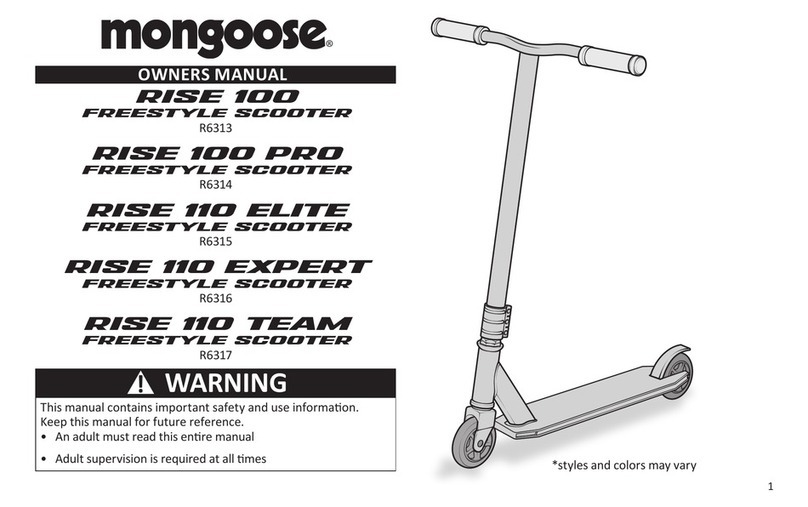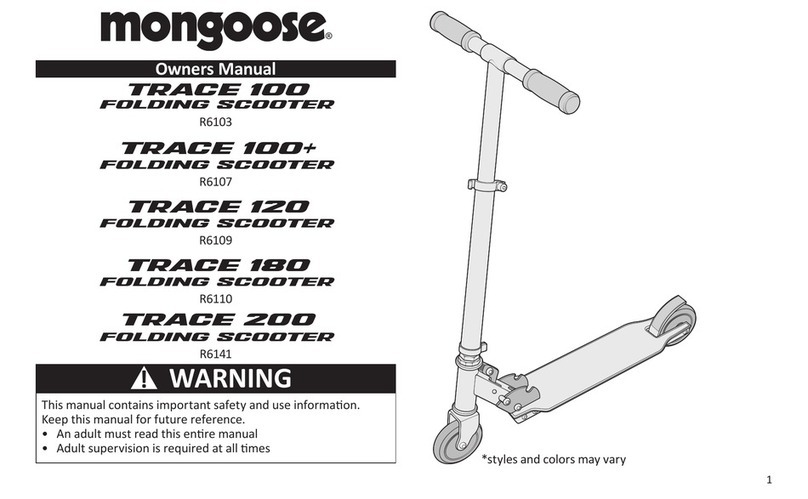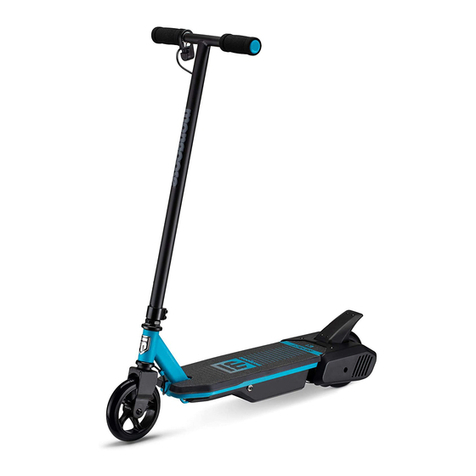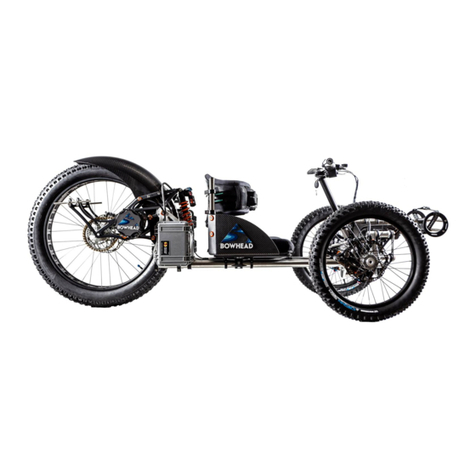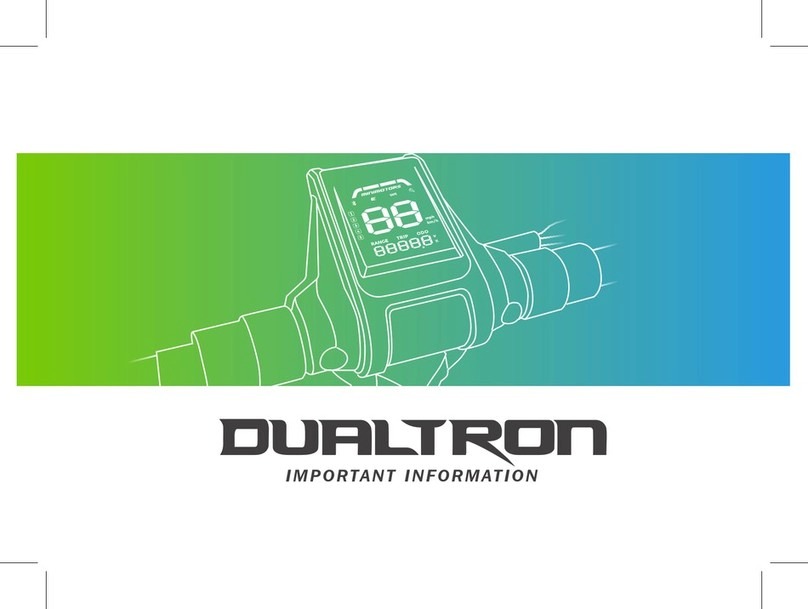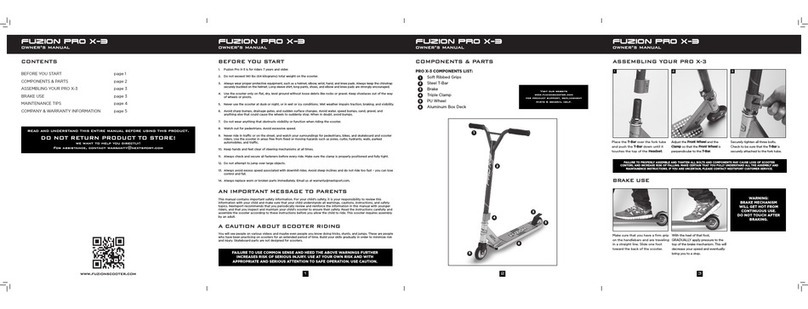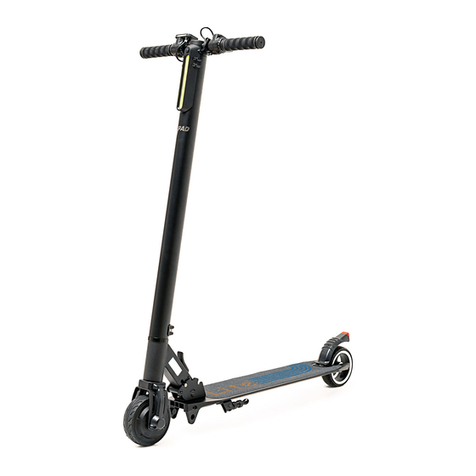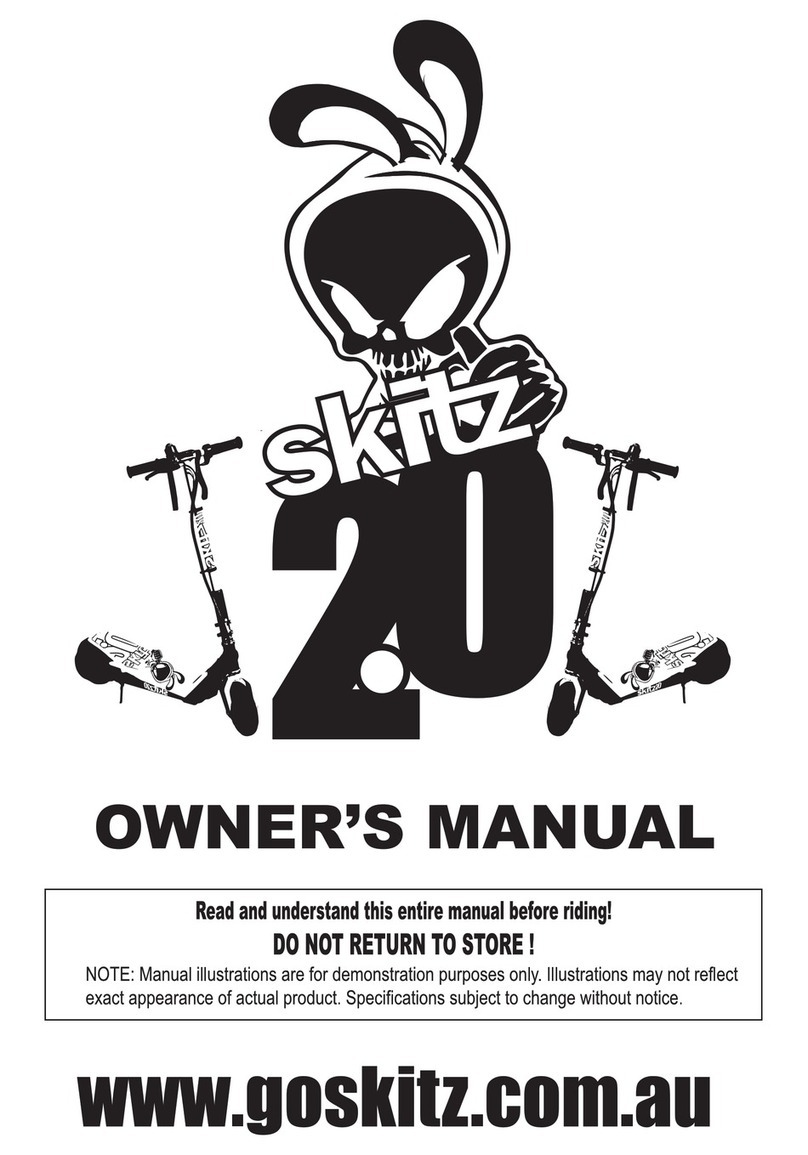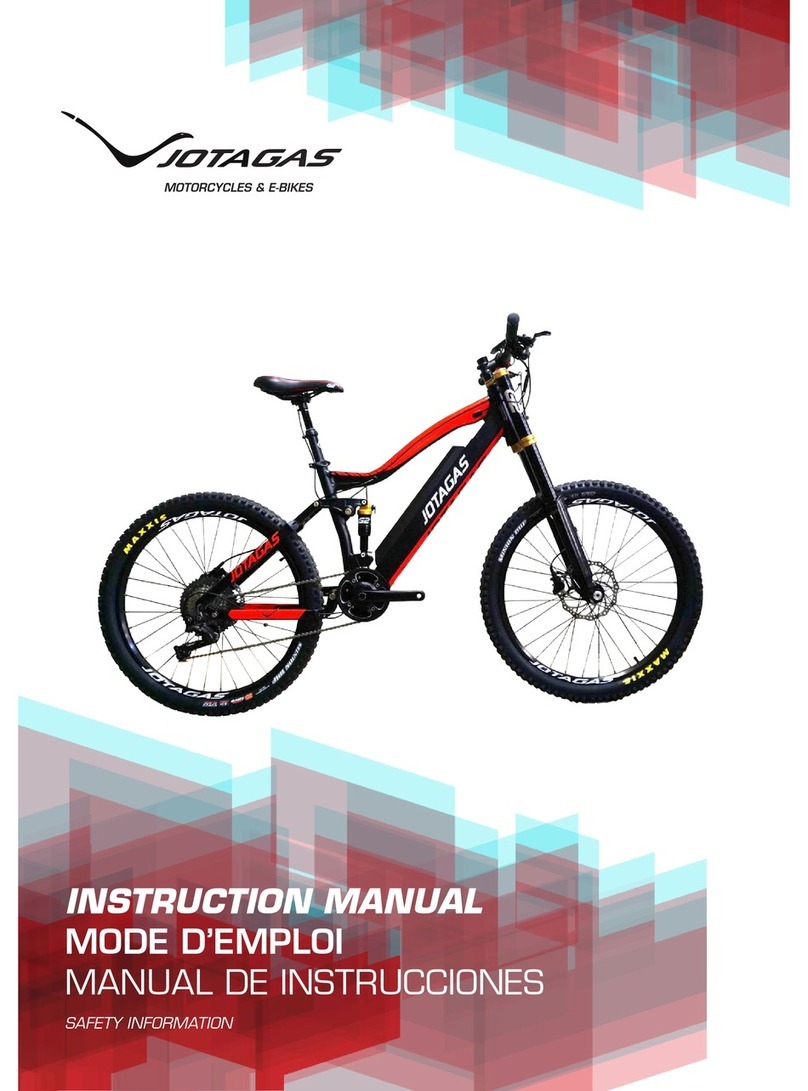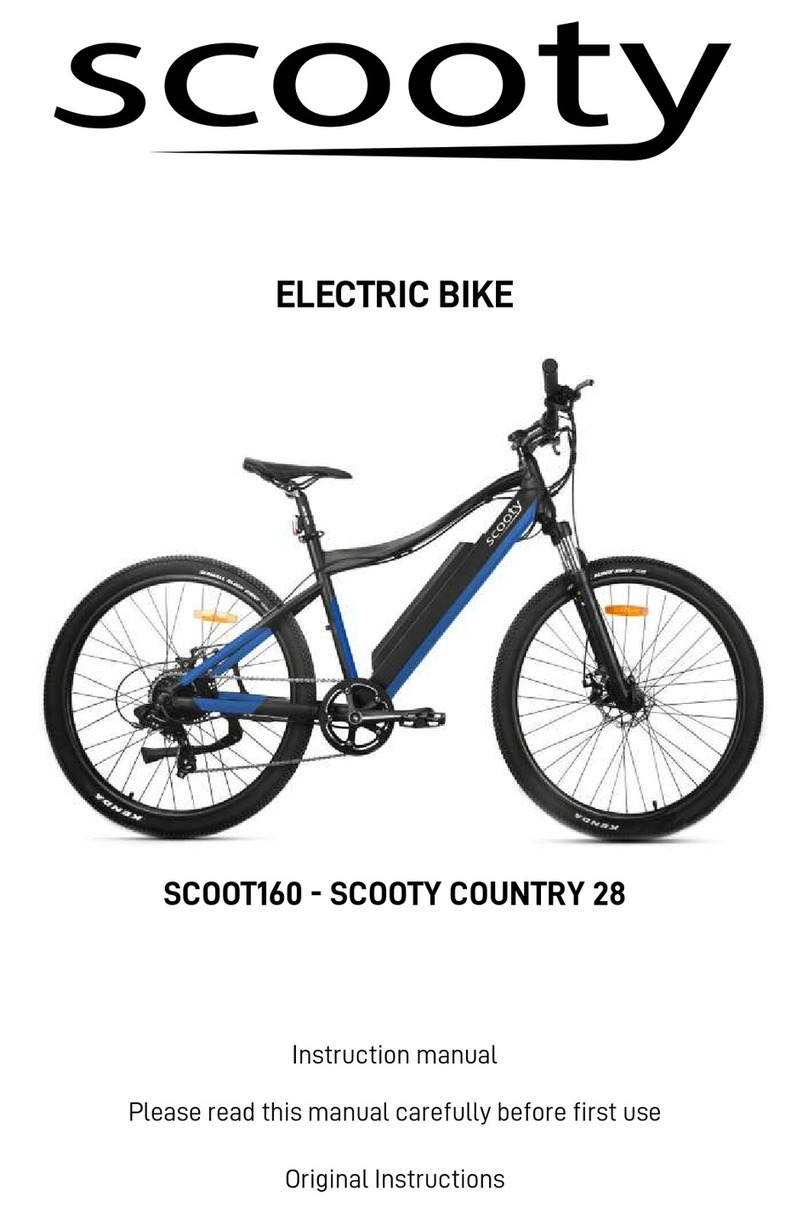Mongoose R6174 User manual

SCOOTER OWNER'S MANUAL
THIS MANUAL CONTAINS IMPORTANT SAFETY, PERFORMANCE AND MAINTENANCE
INFORMATION. READ THE MANUAL BEFORE TAKING YOUR FIRST RIDE ON YOUR
NEW SCOOTER, AND KEEP THE MANUAL HANDY FOR FUTURE REFERENCE.

Contents
1 Safety ............................................4
Safety Signal Words ...............................4
User Responsibility................................4
Personal Safety...................................5
Riding Safety.....................................7
Before You Ride Safety Checklist ....................9
2 Parts Idencaon . . . . . . . . . . . . . . . . . . . . . . . . . . . . . . . . 10
3 Assembly . . . . . . . . . . . . . . . . . . . . . . . . . . . . . . . . . . . . . . . . 12
Tools Required . . . . . . . . . . . . . . . . . . . . . . . . . . . . . . . . . . 12
GengStarted ..................................13
AachtheHandlebar.............................14
AachtheFrontBrakeCable . . . . . . . . . . . . . . . . . . . . . . 15
Cable Detangler . . . . . . . . . . . . . . . . . . . . . . . . . . . . . . . . . 16
AachtheFrontWheel ...........................18
AachtheRearWheel............................19
AachthePegs..................................20
4 Adjustments......................................21
Tools Required . . . . . . . . . . . . . . . . . . . . . . . . . . . . . . . . . . 21
AdjusngtheBrakes . . . . . . . . . . . . . . . . . . . . . . . . . . . . . 22
AdjusngtheHandlebar . . . . . . . . . . . . . . . . . . . . . . . . . . 26
5 Use..............................................28
HandOperatedBrakes ...........................28
Security ........................................29
6 Maintenance . . . . . . . . . . . . . . . . . . . . . . . . . . . . . . . . . . . . . 30
Basic Maintenance ...............................30
LubricaonSchedule .............................31
Parts Maintenance . . . . . . . . . . . . . . . . . . . . . . . . . . . . . . 32
HubBearings....................................34
InangtheTireTube . . . . . . . . . . . . . . . . . . . . . . . . . . . . 34
RepairingaFlatTire ..............................35
TroubleshoongGuide ...........................36
7 Warranty.........................................38
Purchase Record.................................39

2
Congratulaons
onyournewscooter!Properassemblyandoperaonofyour
scooterisimportantforyoursafetyandenjoyment.Our
customerservicedepartmentisdedicatedtoyoursasfacon
withPacicCycleanditsproducts.Ifyouhavequesonsorneed
advice regarding assembly, parts, performance, or returns,
pleasecontacttheexpertsatPacicCycle.Enjoy the ride!
Toll free: 1-800-626-2811.
Customer Service hours:Monday-Friday8AM-5PMCentral
Standard Time (CST)
You may also reach us at:
Web:www.pacic-cycle.com
Email:customerservice@pacic-cycle.com
Mail: P.O.Box344
4730 E. Radio Tower Lane
Olney,IL62450
Do not return this item to the store. Please call Pacic Cycle
customer service if you need assistance. You will need your
modelnumberanddatecodelocatedontheservicescker.
About This Manual
It is important for you to understand your new scooter.
Byreadingthismanualbeforeyougooutonyourrstride,you’ll
knowhowtogetbeerperformance,comfort,andenjoyment
fromyournewscooter.Itisalsoimportantthatyourrstrideon
your new scooter is taken in a controlled environment, away
from cars, obstacles and cyclists.
Thismanualcontainsimportantinformaonregardingsafety,
assembly, use, and maintenance of the scooter but is not
intended to be a complete or comprehensive manual covering all
aspects concerning scooter ownership. We recommend
consulngabicyclemechanicifyouhaveanydoubtsorconcerns
regarding your experience or ability to properly assemble and
maintain the scooter.
A Special Note For Parents and Guardians
It is a tragic fact that most scooter accidents involve children.
As a parent or guardian, you bear the responsibility for the
acviesandsafetyofyourminorchild.Amongthese
responsibiliesaretomakesurethatthescooterwhichyour
childisridingisproperlyedtothechild;thatitisingood
repairandsafeoperangcondion;thatyouandyourchild
have learned, understand and obey not only the applicable local
motorvehicle,scooter,andtraclaws,butalsothecommon
sense rules of safe and responsible bicycling. As a parent, you
shouldreadthismanualbeforelengyourchildridethe
scooter. Please make sure that your child always wears an
approved bicycle helmet when riding.

3
CorrectFing
Make sure your helmet covers your forehead
IncorrectFing
Foreheadisexposedandvulnerabletoseriousinjury
• ALWAYS WEAR A PROPERLY FITTED
HELMET WHEN RIDING YOUR SCOOTER
• DO NOT RIDE AT NIGHT
• AVOID RIDING IN WET CONDITIONS
Helmets
Save
Lives!

4
1 Safety
WARNING!
CAUTION!
SAFETY SIGNAL WORDS
The following safety signal words indicate a safety message.
The symbol alerts you to potenal hazards. Failure to follow the
warning may result in damage to property, injury, or death.
This manual contains many Warnings and Cauons concerning
the consequences of failure to follow safety warnings. Because
any fall can result in serious injury or even death, we do not
repeat the warning of possible injury or death whenever the risk
of falling is menoned.
USER RESPONSIBILITY
All persons assembling, using, and maintaining the scooter must
read and understand the safety warnings and operang
instrucons in this manual before using the scooter.
It is the responsibility of the user, or in the case of a child rider,
an adult, to ensure the scooter is properly maintained and in
proper operang condion. Doing so will reduce the risk of
injury. Always conduct regular maintenance and inspecon of
your scooter. Complete the Safety Checklist at the end of this
secon before each use.
A responsible adult must always supervise the use of the scooter
by a child. You must ensure:
• The child is wearing the proper protecve are and approved
bicycle helmet.
• The scooter is properly ed to the child.
• The child understands applicable laws and common sense
rules of safe responsible scooter riding.
• Rider must be at least 48” tall.
Indicates a hazard or unsafe pracce that will result in severe
injury or death. Failure to read, understand and follow the safety
informaon in this manual may result in serious injury or death.
Indicates a hazard or unsafe pracce that could result in
minor injury.
Indicates a hazard unrelated to personal injury, such as
property damage.
❶Safety
NOTICE

Safety 1
5
Figure 1.1
Riding a scooter without protecve gear, clothing, or a helmet
may result in serious injury or death. Always wear protecve
gear, clothing, and helmet when riding the scooter. Ensure
protecve gear does not interfere with steering, braking, and
pushing.
WARNING!
Protecve Gear and Clothing
Always wear: Figure 1.1
• Colors that are easily seen and, if possible, reecve clothing
• Closed toe shoes
• Clothing appropriate for the weather condions
• Use of protecve gear such as pads for the knees and elbows
is highly recommended for children
• A properly ed, ASTM or SNELL approved, bicycle helmet
shall be worn at all mes by riders of the scooter. For
informaon regarding how to properly t a helmet visit:
hp://www.nhtsa.gov/people/injury/pedbimot/bike/
easystepsweb
Do not wear:
• Loose clothing parts, strings, jewelry that may become
entangled with moving parts on the scooter or interfere with
handling of the scooter.
• Shoes with uned shoe laces.
PERSONAL SAFETY
Properly ed helmet
Elbow pads
Knee pads
Laces ed
Easily seen or
reecve clothing

6
1 Safety
Figure 1.3
Figure 1.2
Helmet Use
Important! Many states have passed helmet laws regarding
children. Make sure you know your states helmet laws. It is your
job to enforce these rules with your children. Even if your state
does not have a children’s helmet law, it is recommended that
everyone wear a helmet.
It is strongly advised that a properly ng, ASTM or SNELL
approved, bicycle helmet be worn at all mes when riding your
scooter.
The correct helmet should: Figure 1.2
• Be comfortable
• Have good venlaon
• Fit correctly
• Cover forehead
Incorrect helmet posion: Figure 1.3
• Helmet does not cover the forehead

Safety 1
7
WARNING!
General Safety
• Familiarize yourself with all the scooter’s features before
riding. Pracce braking.
• Always ride defensively in a predictable, straight line. Never
ride against trac.
• Expect the unexpected (e.g., opening car doors or cars
backing out of concealed driveways).
• Take extra care at intersecons and when preparing to pass
other vehicles.
• Maintain a comfortable stopping distance from all other
riders, vehicles and objects. Safe braking distances and forces
are subject to the prevailing weather condions. Do not lock
up the brakes. When braking, always apply the rear brake
rst, then the front. The front brake is more powerful and if it
is not correctly applied, you may lose control and fall.
• Always use the correct hand signals to indicate turning
or stopping.
• Obey the trac laws (e.g., stopping at a red light or stop sign,
giving way to pedestrians).
• Use original spare parts only. Do Not make structural changes
or modicaons to the scooter.
• Wear proper riding are, reecve if possible, and avoid
open toe shoes.
• Do not use items that may restrict your hearing and vision.
• Do not carry packages or passengers that will interfere with
your visibility or control of the scooter.
Road Condions
• Be aware of road condions. Concentrate on the path ahead.
Avoid pot holes, gravel, wet road markings, oil, curbs, speed
bumps, drain grates and other obstacles.
• Cross train tracks at a 90 degree angle or walk your scooter
across.
• Keep away from motor vehicles and other trac.
Wet Weather
• When riding in wet weather always wear reecve clothing
and use safety lights to enhance visibility.
• Exercise extreme cauon when riding in wet condions.
• Ride at a slower speed. Turn corners gradually and avoid
sudden braking.
• Brake earlier, it will take a longer distance to stop.
• Pot holes and slippery surfaces such as line markings and train
tracks all become more hazardous when wet.
RIDING SAFETY
Riding the scooter in unsafe condions (i.e.: at night), in an
unsafe manner, or disregarding trac laws may result in an
unexpected movement, loss of control, and serious injury or
death.

8
1 Safety
Night Riding
• Important! Riding a scooter at night is not recommended.
Check your local laws regarding night riding.
• Wear reecve and light colored clothing. Wear reecve
clothing and use safety lights for increased visibility.
• Ride at night only if necessary. Slow down and use familiar
roads with street lighng.
Hill Technique
• Do not exceed a comfortable speed; maintain control and
take addional care.
• Braking will require addional distance. Iniate braking slowly
and earlier than usual.
Cornering Technique
• Brake slightly before cornering and prepare to lean your body
into the corner.
• Decrease your riding speed, avoid sudden braking and
sharp turns.
Safe Riding Rules for Children
• Many states require that children wear a helmet while riding.
Always wear a properly ed helmet.
• Do not play in driveways or the road.
• Do not ride on busy streets.
• Do not ride at night.
• Obey all the trac laws, especially stop signs and red lights.
• Be aware of other road vehicles behind and nearby.
• Before entering a street: Stop, look le, right, and le again
for trac. If there’s no trac, proceed into the roadway.
• If riding downhill, be extra careful. Slow down using the
brakes and maintain control of the steering.
• Never take your hands o the handlebars.

Safety 1
9
Before every ride, it is important to carry out the following
safety checks. Do not ride a scooter that is not in proper
working condion! Replace any worn or broken parts as
needed.
Accessories
□Check all parts are secured and funconing correctly before
each ride.
□ All other ngs on the scooter are properly and securely
fastened, and funconing.
□ The rider is wearing a properly ed helmet (protecve gear
if necessary) and that clothing and loose items are properly
constrained.
Bearings
□All bearings are lubricated, run freely and display no excess
movement, grinding or raling.
Brakes
□ The front and rear brakes work properly.
□ The brake shoe pads are not overly worn and are correctly
posioned in relaon to the rims.
□The brake control cables are lubricated, correctly adjusted
and display no obvious wear.
□ The brake control levers are lubricated and ghtly secured
to the handlebar.
Frame and Fork
□The frame and fork are not bent or broken.
Steering
□The handlebar and post are correctly adjusted and
ghtened, and allow proper steering.
□ The handlebars are set correctly in relaon to the forks and
the direcon of travel.
□ The handlebar binder bolt is ghtened.
Wheels and Tires
□ The rims do not have dirt or grease on them.
□ The wheels are properly aached to the scooter and axle.
□ The res are properly inated within the recommended
pressures displayed on the res sidewall.
□ The res have the proper amount of tread, no bulges or
excessive wear.
BEFORE YOU RIDE SAFETY CHECKLIST

10
Expo Scooter
❷Parts Idencaon
Get to know the parts of your scooter. This will help with assembly, maintenance, and troubleshoong. Models vary in color and style.
Part name Torque (-lb)
19 Front fork -
20 Front caliper brake assembly 50 - 70
20A Front brake pads -
20B Front brake pads hardware 50 - 60
20C Brake cable pinch bolt 50 - 70
21 Foot board -
22 Rear caliper brake assembly 50 - 70
22A Rear brake pads -
22B Rear brake pads hardware 50 - 60
22C Brake cable pinch bolt 50 - 70
23 Rear fork -
24 Rear fork dropout -
25 Pegs -
26 Rear re -
Part name Torque (-lb)
1Handlebar grip -
2Rear brake lever 55 - 70
3Brake cables -
4 Stem binder bolt 100 - 120
5 Stem -
6Headset 175 - 260
7Handlebar binder bolt(s) 145 - 200
8Handlebar -
9Front brake lever 55 - 70
10 Frame -
11 Cable splier
12 Front brake aaching nut 70-85
13 Valve stem -
14 Spoke -
15 Rim -
16 Tire
17 Wheel axle nut (front and rear) 180 - 240
18 Front fork dropout -

Parts Idencaon 2
11
3
4
8
7
2
21
10
25
19
12
5
6
9
20
13
11
26
1
18
17
16
15
14
20A
20B
20C
22
22A
22B
22C
23 24

3Assembly
12
Figure 3.1
WARNING!
• Improper assembly of this product may result in serious
injury or death. Always follow the instrucons in this
manual and check crical components (e.g. wheels, brakes,
res) before each use.
• We recommend that you consult a bicycle mechanic if you
have doubts or concerns as to your experience or ability to
properly assembly, repair, or maintain your scooter. If your
scooter was obtained assembled, we recommend that you
read these instrucons and perform checks specied in
this manual before riding.
If you need replacement parts or have quesons pertaining to
the assembly of your scooter, call the service line direct at:
1-800-626-2811. Monday - Friday 8:00 am to 5:00 pm Central
Standard Time (CST).
TOOLS REQUIRED
• Phillips head screw driver
• 4 mm, 5 mm and 6 mm Allen wrench
• Adjustable wrench or a 9 mm, 10 mm, 14 mm and 15 mm
open and box end wrenches
• A pair of pliers with cable cung ability
Your new scooter was assembled and tuned in the factory and
then parally disassembled for shipping. You may have
purchased the scooter already fully assembled and ready to ride
or in the shipping carton in the parally disassembled form. The
following instrucons will enable you to prepare your scooter
for years of riding enjoyment.
For more details on inspecon, lubricaon, maintenance and
adjustment of any area please refer to the relevant secons in
this manual. If you have quesons about your ability to properly
assemble this unit, please consult a qualied bicycle mechanic
before riding.
Assembly
❸

Assembly 3
13
13
Figure 3.2
GETTING STARTED
❶Open the carton from the top and remove the scooter.
Figure 3.2
❷ Remove the straps and protecve packaging from the
scooter. Important! Do not discard packing materials unl
assembly is complete to ensure that no required parts are
accidentally discarded.
❸Inspect the scooter and all accessories and parts for
possible shortages. It is recommended that the threads and
all moving parts in the parts package be lubricated prior to
installaon. Note: We recommend using a lithium based
grease on the parts before assembly.
Handlebar assembly
Pegs (2)
Wheels (2)
Frame

3Assembly
14
Figure 3.3
ATTACH THE HANDLEBAR
❶Turn the front fork to face forward. Figure 3.3
❷Insert the handlebar assembly into the handlebar bracket
with the brake levers on the outside. Align the handlebar so
it is centered with the front wheel.
❸ Place the handlebar clamp plate over the handlebar,
aligning the holes in the plate with the holes in the
handlebar bracket.
❹ Insert the handlebar binder bolts (4 total) through the plate.
Using at 6 mm hex wrench, ghten the bolts.
❺ Using a 14 mm open-end wrench, ghten the stem binder
bolt at the top of the stem post. Check the handlebar binder
bolt(s) to be sure they are properly ghtened and the
handlebar is clamped in place.
WARNING!
• Improper aachment of the handlebar may result in
damage to the stem post, steering tube and result in lose of
control, serious injury or death. Ensure the minimum
inseron marks on the stem post are not visible above the
top of the headset.
• Failure to properly ghten handlebar components may
result in lose of control, serious injury or death. Always
check the handlebar cannot move and is secured to the
frame before riding the scooter.
❻Look at all the cables to be sure they run in a smooth arc
from the brake lever to the front brake or cable stop on the
frame. Important! If they are twisted or kinked, braking will
not work.
Note: See Secon 4: Adjusng the Handlebar if adjustments
are needed.
Front fork
facing forward
Handlebar
binder bolts
Handlebar clamp
plate
Stem binder bolt
1
5
3
4Handlebar bracket
2
6

Assembly 3
15
15
Figure 3.4
Figure 3.5
Figure 3.6
ATTACH THE FRONT BRAKE CABLE
Failure to properly set the brakes may result in the inability to
stop the scooter movement and cause serious injury or death.
Be sure the brakes are funconing properly before using the
scooter.
❶ Rotate the cable adjustment barrel and cable nut unl the
slots are aligned with the slot on the brake lever body.
Figure 3.4
❷ Press the brake lever towards the grip.
❸ Bring the brake cable from the stem over the handlebar and
Slide the brake cable through the slots and place the cable
head into the brake lever. Figure 3.5
❹Release the brake lever. Figure 3.6
❺ Lightly pull on the cable and rotate the cable nut and cable
barrel so they are no longer aligned.
Note: See Secon 4: Adjusng the Brakes if adjustments
are needed.
WARNING! Cable adjustment
barrel slot
Cable nut slot
Brake cable slot Brake lever
Cable head
Brake cable
4
2
5
3
1

3Assembly
16
CABLE DETANGLER
Some scooters are equipped with a cable detangler for the rear
brake. Follow these steps to aach the upper cable to the rear
brake lever. Figure 3.7
❶ Loop the upper cables through the opening on the
handlebar. Note: One of the upper cable casings is shorter
than the other. The shorter side should be on the right. This
is the shorter distance between the brake lever and the
upper detangler plate.
❷ On both sides, place the cable through the upper plate and
thread the adjusng barrels into it.
❸ Insert the cables into the slots on the bearing plate. Note:
The lower cables should already be aached to the tabs on
the bearing unit.
❹ Squeeze the brake lever several mes to be sure all the
cables are seated in the adjustment barrels. If there is
excess play before the brake cable starts to move, this can
be adjusted by turning the adjustment barrels.
a. First adjust the barrel adjuster at the mid point of the
upper cable unl the brake lever does not have any
free play.
b. Next squeeze the brake lever and allow it to return.
c. Check to see if the bearing unit booms out on the
lower detangler plate. If so, unscrew the adjust barrel
further unl the bearing unit sits about 1 mm above
the lower plate. This is the correct posion for the
bearing unit.
❺Rotate the handlebars back and forth and then turn them
completely around 360 degrees. Observe if the bearing unit
spins quietly, or if it “ops” back and forth. If it has any op,
this can be ne-tuned with the four adjustment barrels in
the upper and lower plates. The goal is to reduce or
eliminate as much of the op as possible, while keeping the
brake funcon consistent.
❻ Turn the handlebars 360 degrees and note whether the plate
ops forward and back, or if it ops the same way. If it ops
forward and back, adjust the upper cable barrel adjusters
unl the op is reduced. If the op is the same way, then
adjust the lower cables unl the op is reduced. Somemes
both need to be adjusted. The best thing to do is to adjust the
lower cables rst unl the bearing unit has an equal gap on
the le and right sides, then adjust the upper barrel
adjusters unl the op is minimal or none at all.
Note: See Secon 4: Adjusng the Brakes for further
adjustment of the caliper brakes.

Assembly 3
17
17
Figure 3.7
Front View of Scooter
Single cable
casing
Cable
adjuster Cable
splier
Upper cable
(short casing)
Upper plate Bearing unit
Important! The gap between the plates and
bearing unit should be a minimum 1 mm (1/32”)
when the brake is engaged or disengaged.
Lower plate
Lower cable Lower cable
Locknut
Upper cable adjusng barrels
Locknut
Upper cable
(long casing)
Front brake
cable
Rear brake
lever
Front brake
lever
Cable adjusng
barrel
2
1
4
Lower cable adjusng barrels
3
4
1 mm
(1/32")
1 mm
(1/32")

3Assembly
18
Figure 3.8
Figure 3.9
ATTACH THE FRONT WHEEL
❶Loosen the axle nuts on the front wheel. If there is a washer
inside of the axle nut, it belongs outside of the fork
dropouts.
❷ Posion the front wheel between the front fork legs with
the axle resng inside the fork drop out. Figure 3.8
Important! Be sure the wheel is as centered as possible
between the fork legs.
❸ Place the clip retaining washer on the axle and slide it up
against the fork drop out. Make sure the hooked end is
inside the small hole of the fork dropout. Figure 3.9
❹ Place the two outer axle nuts on and ghten evenly. Tighten
one side part way, then ghten the other side and repeat
unl both sides are ghtened securely. Be sure that the
wheel remained centered between the fork legs.
❺ If it is o center, loosen the axle nut on the side that has a
smaller gap between re and fork leg and use your hand to
push the wheel to a centered posion; hold the wheel with
one hand and ghten the axle nut and check again. Repeat if
needed to be sure the wheel is centered and securely
ghtened.
Axle nut
Clip retaining
washer
Dropout hole
Axle
Fork dropout
Clip retaining
washer inserted
into dropout hole
3
3
2
3
4
4

Assembly 3
19
19
Figure 3.11
Figure 3.10
ATTACH THE REAR WHEEL
❶Loosen the axle nuts on the rear wheel. If there is a washer
inside of the axle nut, it belongs outside of the fork
dropouts.
❷ Posion the rear wheel between the rear fork legs with the
axle resng inside the fork drop out. Figure 3.10
Important! Be sure the wheel is as centered as possible
between the fork legs.
❸ Place the clip retaining washer on the axle and slide it up
against the fork drop out. Make sure the hooked end is
inside the small hole of the fork dropout. Figure 3.11
❹ Place the two outer axle nuts on and ghten evenly. Tighten
one side part way, then ghten the other side and repeat
unl both sides are ghtened securely. Be sure that the
wheel remained centered between the fork legs.
❺ If it is o center, loosen the axle nut on the side that has a
smaller gap between re and fork leg and use your hand to
push the wheel to a centered posion; hold the wheel with
one hand and ghten the axle nut and check again. Repeat if
needed to be sure the wheel is centered and securely
ghtened.
Axle nut
Clip retaining washer
Axle
Fork dropout
Clip retaining
washer inserted
into dropout hole
3
3
2
3
Dropout hole
4
4
Table of contents
Other Mongoose Scooter manuals
Popular Scooter manuals by other brands
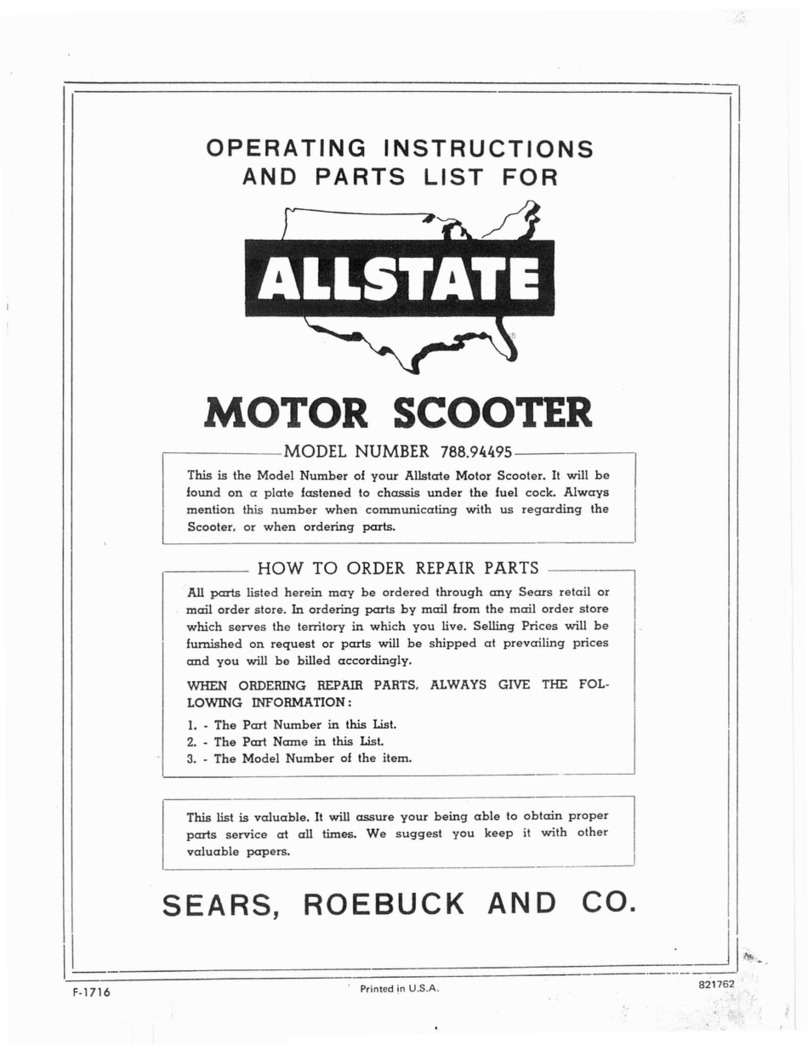
Allstate
Allstate 788.94495 Operating instructions and parts list

Hudora
Hudora BigWheel Generation V 205 INSTRUCTIONS ON ASSEMBLY AND USE

URBANGLIDE
URBANGLIDE MANUEL D'UTILISATION ECROSS PRO BOOST Original manual
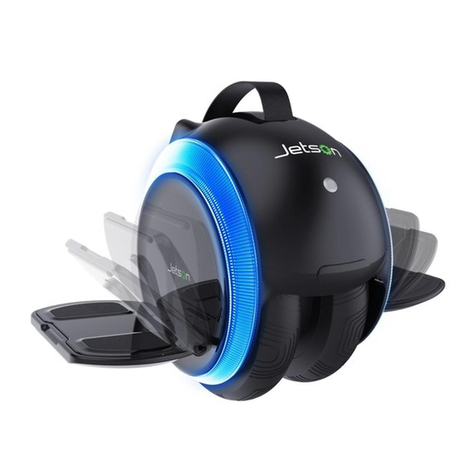
Jetson
Jetson PROTON manual
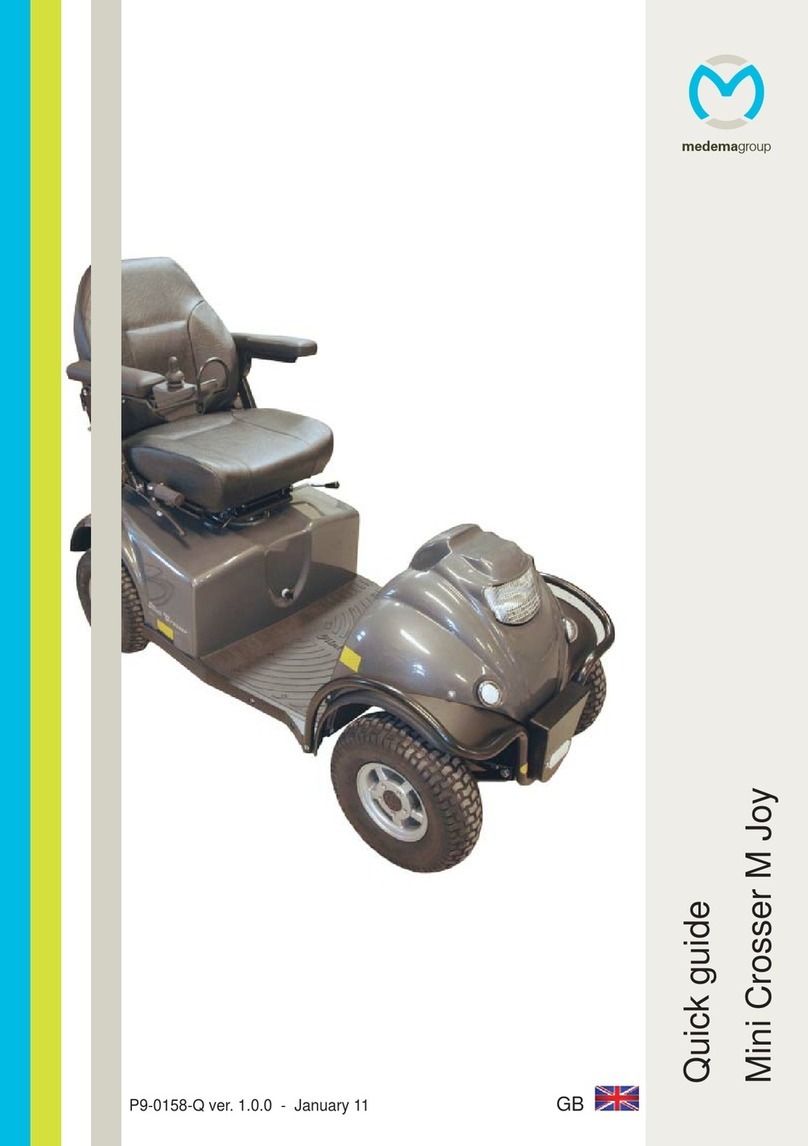
Medema
Medema M Joy quick guide
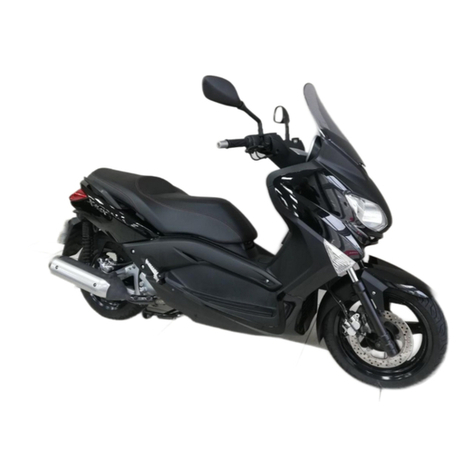
Yamaha
Yamaha XMAX YP250R owner's manual
